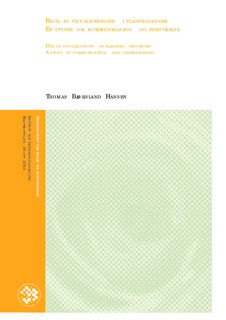Bruk av visualiseringer i planprosesser : en studie om kommunikasjon og forståelse
Master thesis
Permanent lenke
http://hdl.handle.net/11250/188486Utgivelsesdato
2013-08-23Metadata
Vis full innførselSamlinger
- Master's theses (ILP) [763]
Sammendrag
Denne studien tar for seg bruk av visualisering i planprosesser og hvordan dette benyttes til å formidle
informasjon på. Med mange ulike måter å visualisere på er det viktig å være bevisst i valgene man gjør
når man skal utarbeide visualiseringer. Dette gjelder blant annet valg av presentasjonsmetode, verktøy
og hensikten bak utarbeidelsen av visualiseringene. Studien ser også på etikk og lovgivning rundt
visualisering i planprosesser.
For å undersøke hvilke visualiseringsmetoder som egner seg best til å formidle ulik informasjon på,
ble det utført to typer spørreundersøkelser. Den ene spørreundersøkelsen var landsomfattende og
undersøkte blant annet hvordan visualisering brukes i Norge i dag. Den andre spørreundersøkelsen
ble utført i Universitetet for miljø- og biovitenskaps (UMB) virtual reality laboratorium og undersøkte
hvordan tre ulike visualiseringsmetoder blir forstått og opplevd. Studieobjektet for spørreundersøkelsen
var prosjektet "Campus Ås, Samlokaliseringsprosjektet".
Funnene viser at den mest engasjerende og forklarende måtene å formidle informasjon på er ved hjelp
av 3d-visualiseringer. Til tross for at kart, plantegninger, snitt, oppriss og BIM-modeller kan være
mindre engasjerende og forklarende viser funnene at det å bruke ulike metoder i kombinasjon med
hverandre kan gi en bedre helhetsforståelse for et prosjekt.
Studien viser også at det kan finnes en del naivitet blant mottakere av visualiseringer, noe som åpner for
en diskusjon rundt innføring av etiske retningslinjer eller et lovverk. Det kan ikke konkluderes med at
det finnes et behov for slike tiltak, men det er flere funn som indikerer at det eksisterende lovverket er
utdatert når det gjelder visualiseringer i planprosesser. The present study examines the process of visualization in planning and how it is being used as a mean
to communicate information. With several ways to visualize it is important to be fully aware of the
choices being made in the process of making a visualization. This awareness applies to the method of
presentation, the tools being used and the actual purpose of the visualization. The study also considers
the ethics and legislation of visualization in planning processes.
To determine which methods of visualization that are best suited to convey different information,
two types of surveys were conducted. The first survey was a nationwide survey and sought to find out
how visualization is being used by planners in Norway today. The second survey was conducted in
the virtual reality laboratory at the Norwegian University of Life Sciences (UMB) and sought to find
out how three different methods of visualization is being understood and experienced. The case of the
survey is the project "Campus Ås, Samlokaliseringsprosjektet".
The findings shows that the most engaging and best understood method to convey information is by
using 3d-visualizations. Despite the fact that maps, floor plans, sections, elevations and BIM-models
can prove to be less engaging and understandable, the findings indicates that the use of mixed methods
can provide a better overall understanding of a project.
The study also shows that there might exist some naivety among recipients of visualizations. This opens
for a discussion regarding an introduction of ethical guidelines or regulations. However it cannot
be concluded in this study that there is a need for such measures, but the findings indicates that the
existing legislation is outdated in terms of visualization in planning processes.
